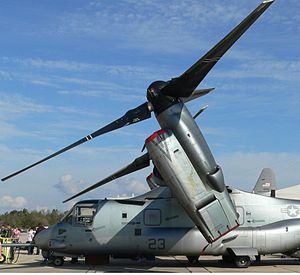Rolls-Royce T406
| T406 / AE 1107C-Liberty | |
|---|---|
 |
|
| A T406 engine Nacelle on a V-22 | |
| Type | Turboshaft |
| National origin | United States |
| Manufacturer |
Allison Engine Company Rolls-Royce plc |
| Major applications | V-22 Osprey |
The Rolls-Royce T406 (company designation AE 1107C-Liberty) is a turboshaft engine that powers the Bell-Boeing V-22 Osprey tiltrotor. The Osprey is in service with the United States Marine Corps and United States Air Force. The engine delivers 6,000 shp (4,470 kW).
The T406/AE1107C Liberty shares a common core with the AE 3007 and AE 2100 series of engines.
The V-22's T406 powerplants are housed in wing-tip tilting nacelles, allowing the distinctive flight characteristics of the V-22. For take off and landing the nacelles are directed vertically (90° to fuselage), while for forward flight they are rotated parallel to fuselage. The engine has been considered as a cost-effective upgrade for existing heavylift helicopters such as the CH-47 Chinook and the CH-53.
In 2009 the GAO found that the engines failed after less than 400 hours of service, as compared to the estimated life of 500–600 hours. Multiple updates to the engine platform in 2012-2013 have increased the lifespan significantly.
In April 2012, the DoD ordered 70 AE 1107C engines for the Osprey, with options for up to 268 engines.
Engines with a future block 4 upgrade are expected to deliver ten thousand horsepower.
The MT7 gas turbines that will be used to power the Ship-to-Shore Connector are a derived design of the T406.
An ongoing problem with the engines was their propensity for surging or stalling with 68 incidents reported between 2003 and October 2016 though this rate had reduced after the introduction of the Block 3 engine version. The US Naval Air Systems Command intends to award Rolls Royce two contracts to examine the effectiveness of proposed reliability improvements, the first is a software tweak to the engine management software for the compressor guide vanes that internal testing showed could improve surge margin by 0.8% at sea level and 3% at altitude. The second is the discovery that a temperature sensor at the inlet of the compressor sends incorrect readings leading to 2.5% out of 4% steady power shortfall at the compressors correct rotational speed again correctable with a software fix. In addition Bell-Boeing are developing an inlet barrier system to reduce the power loss from the engine ingesting dust and sand particles to supplement the engines existing centrifugal based particle separators as they can only do so much to improve the quality of air they receive.
...
Wikipedia
